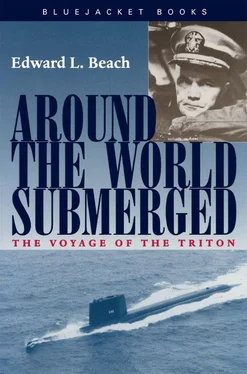The only trouble was that it took both of our periscopes to perform this little stunt, inasmuch as one had to be used to receive return signals while the other one was transmitting; and after we had satisfied ourselves that it would work, and had tired of the performance, Macon kept trying to talk to us by flashing her light just when I wanted to use the periscope for other purposes.
0245 Approximately in position for the transfer.
0250 Broached on safety tank. Ship’s depth gauge reduces to 42 feet, indicating that the top of the conning tower should be three feet out of water. All hands are ready; the lower conning tower hatch is shut. I hastily don a jacket and a cap and then direct Curtis K. Beacham, QM1 (SS), to crack open the conning tower upper hatch very cautiously in case the gauges at this shallow depth are not precisely accurate or if there is an inch or two of water above it—which indeed there is. A small cascade pours down through the barely opened hatch, and we jam it shut again. This is remedied by a short blast of high pressure air into our most forward tank, thus lifting the bow a foot or two more and giving a better drainage angle to the bridge.
A second time I direct Beacham to open the hatch, and this time no water comes in. We are out of water. He holds it at a quarter-inch opening for a minute or two to be sure that water is not sweeping over it. None does. It is definitely out. “Open the hatch!” I tell him. He flips it open, jumps out. I am right behind him. As I swing up the ladder to the bridge, one deck above, by prearrangement Beacham jumps below again and slams the hatch nearly closed, ready to shut it instantly the rest of the way should the bridge become swamped.
It is a lonely feeling to be the only man topside in an 8000 ton ship which is 99% under water. We have been very careful with our computations, but there’s always the possibility that some miscalculation somewhere, or a sudden change in water density, might send her suddenly back down again. There is however not much time to dwell upon this, and besides there’s every chance it will not happen. Triton’ s crew is too well trained, too intent on doing this thing correctly. Will Adams, Bob Bulmer and Tom Thamm are down below watching over this operation like old mother hens, and nearly everyone else is standing by his station just in case. There won’t be any mistakes down there.
All looks well on the bridge, though I notice that one of the hand rails has been broken loose by the force of the water and will undoubtedly be a source of rattles in the future if it is not already. Otherwise, everything looks about the same as it did three weeks ago when we submerged. It is pretty dark but there seems to be fair visibility, despite a drizzle of rain. I fumble for the bridge command speaker, find the knob just where it is supposed to be. Pressing upon it, I call the conning tower and, to our mutual and infinite pleasure, Will Adams immediately answers from down below. We had pretty well expected this instrument to be grounded out from its prolonged submergence and it is a boon to find it in working order.
With communication once established, things are a great deal easier. I pick up the binoculars, scan the Macon and the water between us. We are lying to, stern into the wind, about five hundred yards downwind from her. She is broadside to us, her decks amidships ablaze with lights where her deck crew is hoisting out a motor whaleboat. All we have to do is receive their boat, when it comes, and keep a careful watch on the other ship to ensure that she does not drift down upon us. This will be easy, since our radar is constantly reporting ranges.
I reach forward, press the 7MC command communication button and call into it, just to make sure: “Control, Bridge; keep and log ranges to the Macon and report immediately when she commences to close.”
The return from Bob Bulmer in the control room is immediate; “Range 600 yards, Bridge, and steady.”—Then a minute later, “Bridge,—from the Macon, their boat is in the water heading toward us.”
I acknowledge over the 7MC and direct my next order to Will Adams in the conning tower. “Conn, Bridge—send George Sawyer and the topside line handling party to the bridge, through the conning tower hatch.” We had already arranged that this group of people under our First Lieutenant and Gunnery Officer would be standing by with all necessary equipment. Upon the order they would proceed up one by one to the bridge and prepare to receive the lines from the Macon’s boat when it comes alongside.
Two of them had been directed to break out paint pots and brushes and carry them down with them to slosh paint over the number on the side of the sail, after which the brushes and pots would be discarded overboard. I had not been too keen on this idea when it was first suggested, but had allowed myself to be talked into it. It did have merit, of course, but I found myself wondering how these men were going to manage paint can and brush in one hand and hang on to the handrail on the side of the sail with the other.
Will Adams’ answer from Conning Tower comes back immediately. “Line handlers are standing by. We will open the lower conning tower hatch as soon as ready.”
A few minutes later, “Bridge, Conn—request permission to open the bridge hatch and send line handling party topside.” I press the speaker button and respond, “Bridge, aye. Permission granted.”
In a moment George Sawyer’s determined voice resounds from the bridge, “Line handlers on the lower bridge, sir, Sawyer and four men.”
I have been looking over the side to decide which is the better angle for the boat to approach from; the starboard side looks a bit better; besides, the access door from our sail is on that side. “Stand by to take them alongside the starboard side, George,” I call down to him, “I’ll signal the boat to make our starboard side.”
“Starboard side, aye aye,” from Sawyer. The four people with him are Peter P. J. Kollar, Gunner’s Mate First Class; Wilmot A. Jones, Torpedoman’s Mate Second Class and recently King Neptune’s Royal Consort; Thomas J. Schwartz (the profile), Torpedo-man’s Mate Third Class; and David E. Boe, Seaman.
The noises emanating from the lower bridge indicate that Lt. Sawyer and his men are breaking out the necessary gear, stored there in a watertight tank, to receive the boat alongside. Each man has on an inflatable life jacket with attached flashlight, and a safety belt with traveler.
The latter device is the result of an accident several years ago in northern latitudes, when the US Submarine Tusk rescued the crew of the sinking submarine Cochino. In preparation for the rescue, Tusk rigged lifelines on deck forward. Nevertheless, a huge sea came aboard, swept the people on deck off their feet against the lifeline and broke it, plunging them all into the sea. Herculean efforts on the part of the Tusk got most of them back aboard, but a number lost their lives in the freezing water.
As a result of this accident, a safety track similar to a railroad rail was installed on the decks of all submarines. Anyone going topside in bad weather or under hazardous conditions wears a strong canvas belt, with chain and traveler attached. The traveler clamps over and slides along the safety track, and may only be put on or removed from the track at certain places. This arrangement permits a man to move back and forth on deck and still remain firmly attached to the ship by a short length of very strong chain [with a “quick release” snap-hook in case of need].
When two people want to pass each other, the technique is to seek a safe moment and quickly exchange travelers by unsnapping the chains from one’s own belt and snapping the other man’s into it.
Читать дальше












